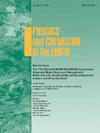Lithofacies, petrography and geochemistry of the Neoproterozoic Sharaban formation, Kirana Malani Basin: Implications for paleotectonics and paleogeography of the Indian shield
IF 3
3区 地球科学
Q2 GEOSCIENCES, MULTIDISCIPLINARY
引用次数: 0
Abstract
The Sharaban Formation, dating to the Neoproterozoic era, is found at the Kirana Hills within the Indian Shield Elements. Metasedimentary rock characterizes the Machh Supergroup's latest unit. New geological interpretations have emerged from the analysis of these metamorphosed and structurally deformed metavolcanic successions. This research characterizes the highly metamorphosed Kirana Group metasandstones and metaconglomerates. Metasandstone and metaconglomerate have unique main sedimentary and syn-sedimentary deformational structures, according to our findings. The present research provides a comprehensive analysis of the Neoproterozoic Sharaban Formation through the integration of field observations, petrographic analysis, geochemical techniques (XRD, SEM), isotopic investigations, seismic imaging, and regional datasets. The metaconglomerate reveals an unconformity within the Kirana Supergroup and provides insights into the origin of the clasts, along with the geological events that led to their deposition. The analysis of these facies via microphotographs indicates the existence of quartzitic textures and a predominant quartz arenite composition. The presence of recrystallized quartz grains and the orientation of mica minerals indicate that the metamorphic process occurred under conditions of low temperature and pressure. Calcitic to quartz overgrowth cements reduce the pore spaces within metasandstone. This formation features outcrops characterized by substantial cavernous pores, likely resulting from telodiagenesis. Intracratonic sag basins experienced modifications due to the transition from river environments to beach settings, encompassing shoreface and backshore zones. The complete Neoproterozoic sequence of the Kirana Supergroup offers significant geological insights into the initial history of the Kirana-Malani Basin, as well as its similarities with regions in Siberia, China, and Oman.
Kirana Malani盆地新元古代Sharaban组岩相、岩石学和地球化学:对印度盾的古构造和古地理的启示
Sharaban组可追溯到新元古代,位于印度盾质元素的基拉纳山。变质沉积岩是马赫超群最新单元的特征。对这些变质和构造变形的变质火山序列的分析产生了新的地质解释。本研究以基拉纳群变质变质变质岩和变质砾岩为主要特征。变质砂岩和变质砾岩具有独特的主沉积和同沉积变形构造。本研究通过野外观测、岩石学分析、地球化学(XRD、SEM)、同位素、地震成像和区域数据等综合手段,对新元古代沙拉班组进行了综合分析。元砾岩揭示了基拉纳超群内的不整合,并提供了对碎屑起源的见解,以及导致它们沉积的地质事件。通过显微照片对这些相进行分析表明,存在石英结构和主要的石英砂岩成分。石英颗粒的再结晶和云母矿物的取向表明,变质过程发生在低温和低压条件下。钙质到石英的过度生长胶结物缩小了变质砂岩的孔隙空间。该地层的露头以大量的海绵状孔隙为特征,可能是由成岩作用造成的。克拉通内凹陷盆地经历了从河流环境到海滩环境的转变,包括滨带和后滨带。基拉那超群的完整新元古代序列为基拉那-马拉尼盆地的初始历史以及与西伯利亚、中国和阿曼地区的相似性提供了重要的地质见解。
本文章由计算机程序翻译,如有差异,请以英文原文为准。
求助全文
约1分钟内获得全文
求助全文
来源期刊

Physics and Chemistry of the Earth
地学-地球科学综合
CiteScore
5.40
自引率
2.70%
发文量
176
审稿时长
31.6 weeks
期刊介绍:
Physics and Chemistry of the Earth is an international interdisciplinary journal for the rapid publication of collections of refereed communications in separate thematic issues, either stemming from scientific meetings, or, especially compiled for the occasion. There is no restriction on the length of articles published in the journal. Physics and Chemistry of the Earth incorporates the separate Parts A, B and C which existed until the end of 2001.
Please note: the Editors are unable to consider submissions that are not invited or linked to a thematic issue. Please do not submit unsolicited papers.
The journal covers the following subject areas:
-Solid Earth and Geodesy:
(geology, geochemistry, tectonophysics, seismology, volcanology, palaeomagnetism and rock magnetism, electromagnetism and potential fields, marine and environmental geosciences as well as geodesy).
-Hydrology, Oceans and Atmosphere:
(hydrology and water resources research, engineering and management, oceanography and oceanic chemistry, shelf, sea, lake and river sciences, meteorology and atmospheric sciences incl. chemistry as well as climatology and glaciology).
-Solar-Terrestrial and Planetary Science:
(solar, heliospheric and solar-planetary sciences, geology, geophysics and atmospheric sciences of planets, satellites and small bodies as well as cosmochemistry and exobiology).
 求助内容:
求助内容: 应助结果提醒方式:
应助结果提醒方式:


